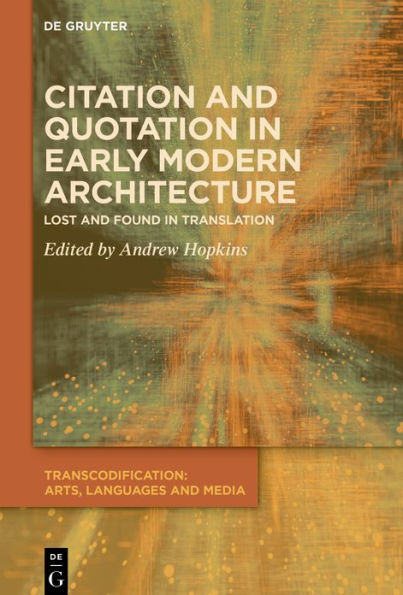Citare in Italian means both to cite and to quote. Citazione means both citation and quotation. This volume, with many discussions of annotations or marginal notes (postils), aims to tease out one of the principal threads of the over-arching theme of what might be termed ‘Lost and Found in Translation’ with regard to Early Modern Architecture. Citation of texts in relation to Early Modern architectural design, treatise writing and theory, has long been studied, but mostly in ways which have never clearly distinguished between three important but different terms: mindset, citation and quotation. This volume charts citation from Filarete and ancient descriptions of Near Eastern Architecture, to difficulties in understanding Vitruvius, and Lost and found in Fra Giocondo’s Vitruvius. The investigation then broadens to Tracing Renaissance Italian Architectural Books in colonial Mexico and an examination of reverse ekphrasis and Early Modern Architecture. It then turns to twisted words and borrowed wisdom: misleading citation in Scamozzi’s Idea dell’architettura universale (1615), before heading East to discuss formats and functions of large-scale calligraphy in late-Ming and Qing-period China and the reconstruction of architectural spaces. Turning to Quotation, the investigation begins with Pirro Ligorio, the ‘Megala’ ship and the Cortile del Belvedere, and invention, imitation and reiteration: the case of Bramante’s Palazzo Caprini and its progeny. Then follows Quoting from memory: centralized models and basilica systems in early counter-reformation Venice, followed by ‘Borrominismo’ in eighteenth century Lisbon, and old form with new function: Villa Emo–Amtshaus Wörlitz, and concludes with found and reshaped in translation: architectural models between centre and periphery. An important reading for anybody interested in Early Modern Architecture.
Citare in Italian means both to cite and to quote. Citazione means both citation and quotation. This volume, with many discussions of annotations or marginal notes (postils), aims to tease out one of the principal threads of the over-arching theme of what might be termed ‘Lost and Found in Translation’ with regard to Early Modern Architecture. Citation of texts in relation to Early Modern architectural design, treatise writing and theory, has long been studied, but mostly in ways which have never clearly distinguished between three important but different terms: mindset, citation and quotation. This volume charts citation from Filarete and ancient descriptions of Near Eastern Architecture, to difficulties in understanding Vitruvius, and Lost and found in Fra Giocondo’s Vitruvius. The investigation then broadens to Tracing Renaissance Italian Architectural Books in colonial Mexico and an examination of reverse ekphrasis and Early Modern Architecture. It then turns to twisted words and borrowed wisdom: misleading citation in Scamozzi’s Idea dell’architettura universale (1615), before heading East to discuss formats and functions of large-scale calligraphy in late-Ming and Qing-period China and the reconstruction of architectural spaces. Turning to Quotation, the investigation begins with Pirro Ligorio, the ‘Megala’ ship and the Cortile del Belvedere, and invention, imitation and reiteration: the case of Bramante’s Palazzo Caprini and its progeny. Then follows Quoting from memory: centralized models and basilica systems in early counter-reformation Venice, followed by ‘Borrominismo’ in eighteenth century Lisbon, and old form with new function: Villa Emo–Amtshaus Wörlitz, and concludes with found and reshaped in translation: architectural models between centre and periphery. An important reading for anybody interested in Early Modern Architecture.

Citation and Quotation in Early Modern Architecture: Lost and Found in Translation
401
Citation and Quotation in Early Modern Architecture: Lost and Found in Translation
401Related collections and offers

Product Details
| ISBN-13: | 9783111478876 |
|---|---|
| Publisher: | De Gruyter |
| Publication date: | 11/18/2024 |
| Series: | Transcodification: Arts, Languages and Media , #5 |
| Sold by: | Barnes & Noble |
| Format: | eBook |
| Pages: | 401 |
| File size: | 30 MB |
| Note: | This product may take a few minutes to download. |
| Age Range: | 18 Years |
